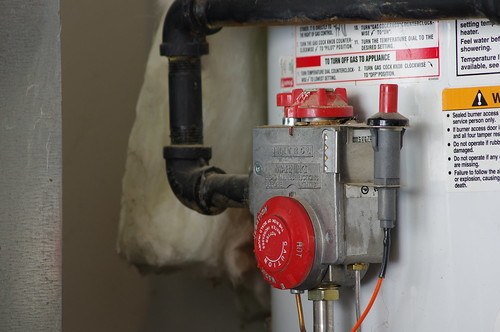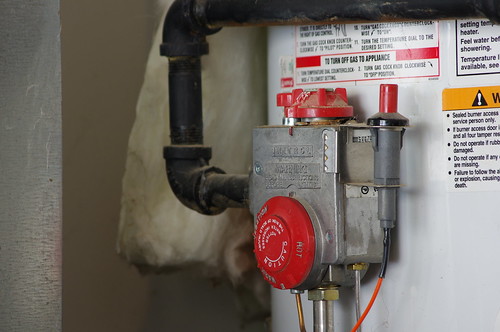
How To Drain a Water Heater
As water heats up in your water heater, sediments such as calcium, magnesium, sand, clay, and other particles naturally settle at the bottom of the tank. Sediment buildup happens gradually in any water heater, though some heaters will suffer from it more than others depending on the quality of the water. Regularly draining your water heater will help flush out this sediment and keep your appliance functioning efficiently for as long as possible. Follow these steps to drain your water heater.
Schedule Your Project for a Convenient Time

Image via Flickr by Scott Akerman
You will need to leave your water heater off for at least a few hours to allow it to cool before you flush it. Ideally, you’ll leave the water heater off overnight. However, this means that you’ll need to plan on going without hot water for a short period of time. You might plan to complete this project on a Saturday morning when you don’t need to shower and go to work.
Alternatively, you can take a hot shower right after turning off your water heater to help drain out the warm water and speed the overall cooling process. In this case, you might turn your water heater off in the morning, take your shower, and leave it to finish cooling during the day for an evening project.
Turn Off Power to Your Water Heater
As mentioned previously, the first step to draining your water heater is turning off power to this appliance. If you have a gas water heater, switch the appliance to “pilot” mode and turn off the gas supply to the appliance. For an electric water heater, you can simply turn off the power at your electrical panel using the appropriate fuse or circuit breaker.
Test the Pressure-Relief Valve
Make sure the pressure-relief valve is working by placing a bucket under the pressure-relief valve and opening the valve. The valve should release either water or a hiss of air. If you experience neither, you should contact a professional plumber for a repair. Return the valve to the closed position before proceeding.
Shut Off the Water Supply
Turn the valve on the top of the water heater to shut off the water going into this appliance. This is crucial since your goal is to empty the water heater. If you skip this step, you’ll be draining a continuous flow of water. At this point, you want to wait for the water to cool before proceeding.
Run a Drain Line
Attach a garden hose to the valve on the water heater and extend the hose to an exterior area where you can dump the water. If you’re in the basement and need to pull the water up and out, you may need to run the first hose to a portable pump that then sends the water onward through a second hose to the outdoors.
Open Your Hot Water Taps
Turn on all the hot water taps in the house. This will help speed the draining process. It’s especially important to turn on the tap closest to the water heater. If this tap is located on the floor above, you’ll find it especially effective at accelerating the draining process.
Flush the Tank
Open the drain valve for the water heater. If you’re using a portable pump, turn this on. Allow the water to drain from the tank completely. If the water flow becomes obstructed by sediment, you may need to place a bucket beneath the drain and remove the valve completely. A dowel rod or screwdriver can help you clear out sediment that’s stuck in the water heater.
Flush Cold Water Through the Tank
Turn the water supply back on and allow cold water to flush through the tank and out the drain hose. This will help remove loose sediment that’s settled in the tank. Continue to let clean water run through the hose until the water comes out clear.
Complete Your Project
Once the water runs clear, you can finish your project. Follow these quick steps:
- Turn the water supply off again.
- Remove the hose and close the drain valve.
- Turn off the open hot water valves in the home.
- Turn the water supply back on to the water heater.
- Restore power to the water heater or turn the gas back on and switch it out of “pilot” mode.
FAQs About Draining a Water Heater
How often should I drain my water heater?
As part of your routine home maintenance, you should drain your water heater at least once a year. This will help flush out sediment and keep your appliance clean. If you have moderately hard water, you may want to increase this to every six months. Those with very hard water should increase the frequency even more.
How can I tell if there’s too much sediment building up in my water heater tank?
If you have a significant amount of sediment buildup in your water heater between flushes, you may experience:
- Popping sounds coming from the water heater as air bubbles up through the sediment on the bottom of the tank.
- Unpleasant odors caused by bacteria in the water heater.
- Little or no hot water caused by excessive sediment buildup around your heating element.
Will draining my water heater clean the tank thoroughly?
The previous steps will help you maintain your water heater and remove minor sediment deposits. However, if you have especially hard water or your water heater hasn’t been maintained properly in recent years, you may need a different solution. A professional plumber can treat your water tank with a delimer solution or manually scrape away some of the sediment for a more thorough removal of sediment and lime scale. If you’re not sure what kind of treatment your water heater needs, a plumber can help you evaluate the situation.
If you’re not comfortable draining your water heater yourself, our plumbers at Dahme Mechanical Industries can help with this essential maintenance task. We can also assist with water heater repairs when you have more significant problems as the result of sediment buildup. Call us today for help.
